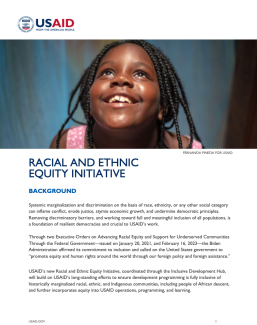For Immediate Release
Office of Press Relations
press@usaid.gov
Statement by Administrator Samantha Power
Historian Annette Gordon-Reed, author of On Juneteenth, remembers celebrating Juneteenth as a little girl in the 1960s with red soda, barbecued goat, and her family. Annette’s mother recounted how, in Jim Crow-era Texas, families would dress up in their Sunday best and head to Emancipation Park to listen to speeches and hear the words of the Emancipation Proclamation read aloud.
In June 1865 – two and a half years after President Lincoln signed the Emancipation Proclamation and two months after General Lee surrendered at Appomattox –Confederate states continued to enslave an estimated 250,000 African Americans. It was only on June 19, 1865, that Union General Gordon Granger arrived in Galveston, Texas, and read General Order No. 3, declaring: “The people of Texas are informed that, in accordance with a proclamation from the Executive of the United States, all slaves are free.”
For generations, Juneteenth was an unofficial holiday celebrated primarily by African Americans to mark the date of true emancipation for nearly a quarter of a million people. A century and a half later, on June 17, 2021, President Biden signed the Juneteenth National Independence Day Act into law, enshrining Juneteenth as the United States’ 12th federal holiday.
As writer Jelani Cobb puts it, “at the heart of that day in Galveston and in the entirety of American life: there is a vast chasm between the concept of freedom inscribed on paper and the reality of freedom in our lives.” Not only did it take two and half years for word of the Emancipation Proclamation to reach enslaved people in Texas, but even after General Granger’s proclamation that day declared the “absolute equality of personal rights and rights of property” for formerly enslaved people, African Americans continued to be subjected to segregation, discrimination, and violence. So, on Juneteenth, we honor those who have worked for centuries to close that chasm between our stated ideals and the lived reality of historically marginalized communities – and advance freedom, equality, and respect for human dignity for all.
USAID is committed to advancing those ideals and working toward the full and meaningful inclusion of all people, both here at home and around the globe. This spring, USAID’s Inclusive Development Hub launched the Racial and Ethnic Equity Initiative to incorporate equity into all USAID policy, programming, and learning. The Office of Civil Rights, Affirmative Employment Division initiated an Agency-wide barrier analysis working group to identify and mitigate or remove barriers that underrepresented groups face at USAID. Over the past two years, USAID has established six Memoranda of Understanding with Minority-Serving Institutions, five of which are Historically Black Colleges and Universities (HBCUs). By proactively reaching thousands of students from these schools, we can build a diverse team comprising the best and brightest America has to offer.
On Juneteenth, as we celebrate the rich diversity of African American culture in our country, we remember that the road toward equity and justice is paved by the tireless efforts of civil rights activists, community leaders, and all those willing to stand up for what is right.

